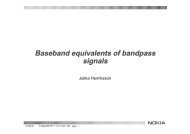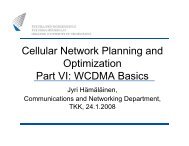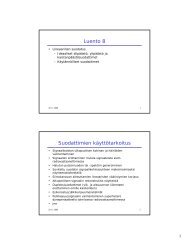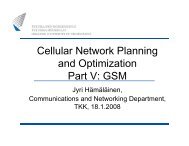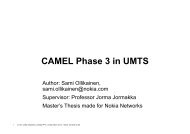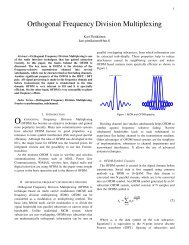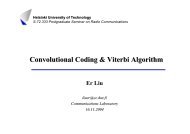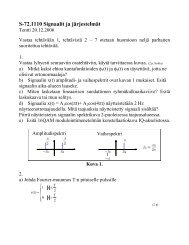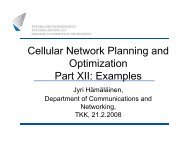Source and Channel Encoder and Decoder Modeling
Source and Channel Encoder and Decoder Modeling
Source and Channel Encoder and Decoder Modeling
You also want an ePaper? Increase the reach of your titles
YUMPU automatically turns print PDFs into web optimized ePapers that Google loves.
S-72.333 Postgraduate Course in Radiocommunications<br />
Fall 2000<br />
<strong>Source</strong> <strong>and</strong> <strong>Channel</strong> <strong>Encoder</strong> <strong>and</strong> <strong>Decoder</strong> <strong>Modeling</strong><br />
Markku Pukkila<br />
Nokia Research Center<br />
markku.pukkila@nokia.com<br />
HUT 12.12.2000
Contents<br />
I. INTRODUCTION....................................................................................................................................................3<br />
II.SOURCE CODING [1] ...........................................................................................................................................4<br />
A.QUANTIZATION......................................................................................................................................................4<br />
B.DIFFERENTIAL QUANTIZATION...............................................................................................................................5<br />
C.ENCODING DISCRETE INFORMATION SOURCES .......................................................................................................6<br />
D.SIMULATION OF SOURCE CODING...........................................................................................................................7<br />
III.CHANNEL CODING [1] ......................................................................................................................................8<br />
A.BLOCK CODES .......................................................................................................................................................9<br />
B.CONVOLUTIONAL CODES.....................................................................................................................................10<br />
C.EXAMPLE (GSM SPEECH)....................................................................................................................................12<br />
D.INTERLEAVING, NONBINARY CODES, CONCATENATION .......................................................................................12<br />
E.SIMULATION OF CODED SYSTEM...........................................................................................................................14<br />
IV.SUMMARY..........................................................................................................................................................15<br />
V.REFERENCES ......................................................................................................................................................16<br />
VI.HOMEWORK......................................................................................................................................................17<br />
2
I. Introduction<br />
This report is concentrating on source <strong>and</strong> channel coding issues <strong>and</strong> especially their modeling<br />
in simulation platforms. <strong>Source</strong> encoding <strong>and</strong> decoding issues are first described. A/D conversion<br />
is the key operation in the transmitter side, so an analog signal is sampled, quantized <strong>and</strong> then<br />
encoded into groups of k bits. In the receiver there is D/A conversion, so the discrete signal is<br />
decoded <strong>and</strong> filtered back to analog signal. Both uniform <strong>and</strong> nonuniform quantization methods are<br />
described as well as differential quantization, which is beneficial for correlated sequence. Also one<br />
method to encode discrete information is presented. The section concludes to some general<br />
remarks about how to simulate source coding systems.<br />
<strong>Channel</strong> coding is used to achieve more reliable transmission by adding redundancy in the<br />
information bits. The most common channel encoding techniques are block <strong>and</strong> convolutional<br />
codes, although so called iterative turbo codes have recently got a lot of interest among<br />
researchers. The block encoders are processing a block of data at a time <strong>and</strong> calculating the parity<br />
check bits for this block after which they read the next input bits to replace the current block.<br />
Convolutional encoders instead introduce memory into the code by using the previous time<br />
instants as well to calculate the current encoder output. Convolutional decoders can be based for<br />
example on MLSE or MAP principles, the former solving minimum sequence error <strong>and</strong> the latter<br />
minimum symbol error. For instance in Full Rate GSM Speech both block <strong>and</strong> convolutional<br />
encoding are used, but on the other h<strong>and</strong>, the end of each burst is kept uncoded as it is not so<br />
critical for human’s ear. Another methods to improve link performance is to use interleaving,<br />
nonbinary codes (more than 2 different symbols available) or concatenate at least two codes<br />
serially or parallel.<br />
The coded system can be divided into encoder/decoder pair <strong>and</strong> a discrete channel between<br />
them. Typically more samples are needed to represent the channel part in a simulation.<br />
Sometimes it is enough to calculate bounds for a codec <strong>and</strong> one can so avoid long <strong>and</strong> complex<br />
simulations. At least with large SNR values one can get reliable bounds.<br />
3
II. <strong>Source</strong> Coding [1]<br />
In Fig. 1 a general source encoding <strong>and</strong> decoding system is presented. Analog information<br />
source is sampled <strong>and</strong> quantized <strong>and</strong> finally represented with binary (or M-ary) symbols b(kT s ). In<br />
the receiver side the received symbols b ˆ( kT s<br />
) are decoded <strong>and</strong> filtered back to analog signal. So<br />
there is an analog-to-digital (A/D) conversion in the transmitter <strong>and</strong> digital-to-analog (D/A)<br />
conversion in the receiver. Typical values in the case of speech are:<br />
• 8000 analog samples per second<br />
• each sample quantized into 2 k levels, k ∈ [ 6,10]<br />
• each quantized sample encoded by a group of k binary values<br />
• total bit rate between 48000 <strong>and</strong> 80000 bits per second<br />
• decoder maps groups of k bits into 2 k levels <strong>and</strong> filters analog signal from that<br />
Analog<br />
Samples<br />
Quantized<br />
Samples<br />
Binary<br />
Digits<br />
Binary<br />
Digits<br />
Quantized<br />
Samples<br />
Analog<br />
Signal<br />
Analog<br />
source<br />
Sample Quantize Encode<br />
Decode<br />
Filter<br />
X(t) X(kT s<br />
) X q<br />
(kT s<br />
) b(kT s<br />
) b ˆ( kT ) ˆ<br />
q<br />
( )<br />
s<br />
X kT ˆ ( )<br />
s X t<br />
Figure 1. Block diagram for source coding system.<br />
The quantization operation typically transforms an analog signal X into a discrete signal X q . This<br />
operation introduces some quantization noise X q -X into the system <strong>and</strong> the system designer tries<br />
to minimize the mean squared error E{(X-X q ) 2 }. If the samples X(kT s ) are uncorrelated, then they<br />
can be quantized independently, but otherwise some data processing is needed to remove<br />
correlation between samples before quantization.<br />
A. Quantization<br />
Classical uniform quantization divides the input voltage into equal intervals, thus ith interval<br />
corresponds to range i∆+(∆/2). When input voltage falls into this range, quantizer gives an output<br />
integer i. Nonuniform quantizer divides the input range into unequal intervals. The input signal is<br />
first processed by a compressor <strong>and</strong> after that with a uniform quantizer. So called µ-law for a<br />
compressor gives x c =v c /V as a function of x=v/V as follows<br />
log(1 + µ x )<br />
x c<br />
= (sgn x)<br />
(1)<br />
log(1 + µ )<br />
4
where v c is the compressor output, v the input,V the maximum input <strong>and</strong> µ is typically 255. So<br />
called A-law is given by<br />
x<br />
c<br />
A x<br />
= (sgn x)<br />
,<br />
1+<br />
ln A<br />
1+<br />
ln A x<br />
= (sgn x)<br />
1+<br />
ln A<br />
0 ≤ x<br />
-1<br />
, A<br />
−1<br />
≤ A<br />
. (2)<br />
≤ x ≤ 1<br />
The source decoder estimates x c by performing simply inverse mapping from the integer i as<br />
follows<br />
−m<br />
m<br />
x ˆ = (sgn x)(<br />
∆ / 2 + i∆),<br />
∆ = 2 , i = 0,1,...,2 −1<br />
. (3)<br />
c<br />
Finally, an estimate on the original input is given by the exp<strong>and</strong>er as follows<br />
−1<br />
xˆ<br />
= sgn( xˆ<br />
) g ( ˆ ) , (4)<br />
c<br />
x c<br />
where (sgn x)g(x) describes the used compressor law (1) or (2).<br />
B. Differential quantization<br />
If the sequence {X(kT s )} is correlated, the variance of the difference X(kT s ) - X((k-1)T s ) is smaller<br />
than the original variance of X(kT s ). Therefore it is beneficial to quantize the difference instead of<br />
the original sequence to achieve lower MSE. In general a predictor uses a linear combination of M<br />
previous values as follows<br />
M<br />
∑<br />
X ˆ ( k)<br />
= a X ( k − i)<br />
. (5)<br />
i=<br />
1<br />
The predictor coefficients a i can be solved from<br />
R<br />
XX<br />
M<br />
i<br />
∑<br />
( j)<br />
= a R ( j − i)<br />
. (6)<br />
i=<br />
1<br />
i<br />
XX<br />
In Fig. 2 transmitter <strong>and</strong> receiver with differential quantization are shown.<br />
5
Transmitter<br />
X(k)<br />
+<br />
Quantizer<br />
-<br />
+<br />
X ˆ ( k )<br />
+<br />
X ( k)<br />
− Xˆ<br />
( k)<br />
Predictor<br />
X ( k)<br />
− Xˆ<br />
( k )<br />
+<br />
-<br />
Receiver<br />
X ˆ ( k )<br />
Predictor<br />
Figure 2. Differential encoding.<br />
C. Encoding discrete information sources<br />
In the case of discrete information source, there are only a limited number of possible symbols<br />
that could be transmitted. <strong>Source</strong> encoding is now transforming original information into a binary or<br />
M-ary sequence. In order to conserve system b<strong>and</strong>width it is beneficial that encoding utilises as<br />
low bit rate as possible <strong>and</strong> that the encoding is unique, hence the original message can be<br />
recovered without errors.<br />
There are many possible algorithms to encode discrete source. Here is given an algorithm that<br />
was first proposed by Shannon <strong>and</strong> which maps M-ary alphabet into binary digits. Let us assume<br />
that the encoder input consists of blocks of N symbols <strong>and</strong> there are q(N) possible messages of<br />
that length. Let p 1 ,p 2 ,…,p q(N) be the probabilities of these messages, <strong>and</strong> p 1 +p 2 +…+p q(N) =1, p 1 > p 2<br />
>…> p q(N) . Then the minimum average number of bits per symbol for these blocks is<br />
H<br />
N<br />
q(<br />
N )<br />
1<br />
= ∑ pi<br />
log<br />
2<br />
(1/ pi<br />
) . (7)<br />
N<br />
i=<br />
1<br />
Shannon proposes the following encoding for the blocks of N symbols. Let<br />
i 1<br />
= ∑ − F<br />
i<br />
p k<br />
<strong>and</strong> F 1 = 0 . (8)<br />
k = 1<br />
Let also n i be a following integer<br />
log<br />
2<br />
(1/ p<br />
i<br />
) ≤ ni<br />
< 1+<br />
log<br />
2<br />
(1/ pi<br />
) . (9)<br />
6
Then the binary encoding for message m i is the binary expansion of F i using up to n i bits. This<br />
algorithm assigns shorter codes for messages of higher probability, which decreases the average<br />
number of bits per symbol.<br />
D. Simulation of source coding<br />
We can observe that idealized A/D operation, uniform or nonuniform quantization, is a simple<br />
memoryless transformation. So it is enough to read input value <strong>and</strong> calculate the corresponding<br />
output. Real A/D converters have many different properties, but very often idealized models will do.<br />
In the receiver end an inverse D/A conversion is performed. Usually first the binary sequence is<br />
mapped into quantized digital sequence <strong>and</strong> after that the sequence is filtered into an analog<br />
signal.<br />
Hence, as we have presented source encoding <strong>and</strong> decoding steps, we can now assume that<br />
encoded binary sequence consists of ’0’ <strong>and</strong> ’1’ with equal probabilities or M-ary sequence with<br />
each symbol equally probably. As we have this assumption, we can replace the actual source<br />
encoder with a (pseudo) r<strong>and</strong>om binary sequence, if we are not particularly interested in source<br />
encoding/decoding, sampling or quantization operations.<br />
7
III. <strong>Channel</strong> Coding [1]<br />
The famous Shannon capacity sets the maximum transmission rate C, where information can<br />
be transmitted with arbitrarily high reliability. For example, in additive white Gaussian noise<br />
channel this capacity is given by<br />
C = B log 2<br />
(1 + S / N)<br />
(10)<br />
where B is the channel b<strong>and</strong>width, S <strong>and</strong> N are signal <strong>and</strong> noise powers, respectively. One method<br />
to approach Shannon limit is to use error control coding in the system, since it enables far more<br />
reliable transmission, although more energy per information bit is needed. The general system<br />
model is given in Fig. 3, where the source data is encoded in the transmitter side <strong>and</strong> the equalised<br />
signal is decoded in the receiver.<br />
Signal<br />
source<br />
<strong>Channel</strong><br />
encoder<br />
Interleaver<br />
Modulator<br />
Multipath<br />
channel<br />
noise<br />
<strong>Channel</strong><br />
decoder<br />
Deinterleaver<br />
Equaliser<br />
Receiver<br />
filter<br />
Figure 3. Block diagram for a system utilising channel coding.<br />
<strong>Channel</strong> coding methods are divided into two different classes, which are block <strong>and</strong><br />
convolutional codes. Block coding is more straightforward to implement, as it is comprised of a<br />
block of information bits <strong>and</strong> some check (parity) bits dependent on the information part. The<br />
convolutional coding uses a continuous data stream, which is processed by a specific finite state<br />
machine. In the recent years so called turbo codes have been a popular research topic, since they<br />
actually can reach very close to Shannon limit. Turbo codes are based on parallel or serial<br />
concatenation of basic (convolutional) codes <strong>and</strong> they were introduced by Berrou et al. 1993 [2].<br />
The benefit of channel coding is usually given as coding gain, which is the difference in SNR<br />
between uncoded <strong>and</strong> coded systems at a certain BER level. Unfortunately, this gain is often very<br />
difficult to calculate analytically (at least in realistic situations), thus the performance is usually<br />
found out by computer simulations.<br />
8
A. Block Codes<br />
In general, a block channel encoder takes a block of k information bits in <strong>and</strong> adds n-k parity<br />
bits in the end of block, thus providing as output n-bit block, which is called a codeword. These<br />
codewords should be carefully designed, so that the channel decoder can recover the original<br />
message, although some transmission errors may have occurred. Hence, the decoder can detect<br />
<strong>and</strong> correct transmission errors, which improves the average bit error rate in the receiver. This kind<br />
of coding methods are called forward error correction (FEC) schemes. To design a specific FEC<br />
scheme, one has to choose values n <strong>and</strong> k, develop a good encoding method to construct parity<br />
bits <strong>and</strong> select a decoding algorithm.<br />
Of course when n is large compared to k, the code makes it possible to detect <strong>and</strong> correct<br />
several transmission errors within a data block. The decoder just compares the received codeword<br />
to all possible words <strong>and</strong> selects the best match. If d min is the minimum Hamming distance between<br />
any pair of words, the code can recover all words having t or less errors, where<br />
d min<br />
⎢ −1⎥<br />
t = ⎢ ⎥ . (11)<br />
⎣ 2 ⎦<br />
The code designer tries to maximise minimum distance d min but also the code efficiency R = k/n.<br />
Large n values would be beneficial in design, but unfortunately they lead to complex<br />
implementation of encoder <strong>and</strong> decoder, <strong>and</strong> therefore rather small values are usually favoured.<br />
One simple example of generating a (7,4) binary block code is given as a shift register in Fig.4<br />
The upper row is filled with input signal <strong>and</strong> then the parity bits in the lower row can be calculated.<br />
Finally, all 7 bits are available at the output.<br />
Input data<br />
x 4<br />
x 3<br />
x 2<br />
x 1<br />
+ + +<br />
Output data<br />
c 7<br />
c 6<br />
c 5<br />
Figure 4. Shift register for generating binary (7,4) code. [3]<br />
<strong>Channel</strong> decoders for block codes are much more complex than encoders due to transmission<br />
errors. A simple comparison between all possible code words <strong>and</strong> the received word becomes<br />
impractical as the block length grows. Therefore different computationally efficient but still<br />
9
easonably well performing decoding algorithms are developed. Part of the decoding methods are<br />
nonalgebraic procedures, while some others exploit algebraic structure of the code. Decoding<br />
performance improves further, if the decoder can use soft values as input. A soft value tells the<br />
decision bit, but also reliability information on that. For example, value 0.8 can denote strong<br />
probability of transmitting 1 <strong>and</strong> –0.9 strong probability of sending 0.<br />
B. Convolutional Codes<br />
In contrast to block codes, convolutional codes are operating with continuous stream of input<br />
data instead of blocks. However, they are also based on the redundancy, which distinguish<br />
different codes from each other <strong>and</strong> enables decoder to detect the correct transmitted sequence.<br />
The convolutional decoders itself differ very much from block decoders, but they are still<br />
characterised by a bit rate R=k/n <strong>and</strong> a distance measure between codes called minimum free<br />
distance d f , which tells how far apart all possible sequences lie from each other.<br />
So convolutional codes introduce some memory in the transmitted sequence, which is easy to<br />
find from the Fig. 5 below. This encoder takes k=2 bits in at the time <strong>and</strong> outputs n=3 each time.<br />
What is more, the same inputs are used to provide two sets of outputs; so called constraint length<br />
L is also 2. Typically, k <strong>and</strong> n are between 1 to 8, <strong>and</strong> R is then between 1/3 (at least in data<br />
services) <strong>and</strong> 7/8 <strong>and</strong> L is from 2 to 10. The convolutional codes are usually expressed with<br />
polynomials that tell which inputs are added in each output. For instance, generator polynomials for<br />
the given (2,3)-code would be 1+D 2 +D 3 , 1+D+D 3 <strong>and</strong> 1+D 2 , where D means one bit delay variable.<br />
+<br />
Input data<br />
Output data<br />
+<br />
+<br />
Figure 5. A 2/3-rate convolutional encoder with L=2, k=2, n=3. [3]<br />
10
Alternative ways to describe encoder structure is to use state or trellis diagrams[3]. State<br />
diagram shows the internal state of the encoder memory <strong>and</strong> its possible movements as time goes<br />
by. Trellis diagram is more thorough, since it actually shows all the possible paths (movements), as<br />
it presents each time instant on the right of the current time instant. In that way, the whole trellis is<br />
saved when time goes on. Trellis diagram is especially h<strong>and</strong>y, if one likes study what happens in<br />
the decoding of the sequence.<br />
The decoding problem of convolutional codes (<strong>and</strong> closely related equalisation problems) is<br />
widely researched area. The two most common approaches (which are also very closely related)<br />
are called the maximum-likelihood sequence estimation MLSE (usually implemented by the Viterbi<br />
algorithm) <strong>and</strong> maximum a posteriori algorithm MAP. These are briefly introduced in the following,<br />
more information is found for instance from [5] about MLSE <strong>and</strong> from [4] about MAP.<br />
The MLSE problem is to find the sequence of transmitted information symbols û, which<br />
maximises the likelihood function as follows<br />
( cˆ<br />
u)<br />
uˆ<br />
= arg max p , (12)<br />
u<br />
where ĉ is the received (encoded) signal from the equaliser. An equivalent problem is to maximise<br />
the log-likelihood function log p(c|u), which is solved by minimising the path metric<br />
PM<br />
=<br />
2 ˆ<br />
( ) 2<br />
c ˆ − UΨ<br />
= ∑ c k<br />
− t k<br />
(13)<br />
k<br />
where the reconstructed encoder output assuming structure Ψ is given as<br />
M<br />
∑∑<br />
− 1 L<br />
m= 0 l=<br />
0<br />
t = u g . (14)<br />
k<br />
m,<br />
k−l<br />
m,<br />
l<br />
In MLSE-VA the trellis is spanned by all the L symbols in (14) <strong>and</strong> each transition is comprised<br />
of M elements, which are describing different encoder outputs. Hence, MLSE finds minimum<br />
sequence error.<br />
The objective of the MAP algorithm is to minimise the bit error probability for each bit by<br />
estimating a posteriori probabilities (APP) of states <strong>and</strong> transitions of the Markov source from the<br />
received signal sequence. The MAP algorithm introduced by Chang <strong>and</strong> Hancock [4] uses the<br />
information of the whole received sequence to estimate a single bit probability. In other words, the<br />
MAP algorithm selects the bit ∈{ −1 , + 1}<br />
uˆ<br />
k<br />
u at time instant k, which maximises the following APP<br />
k<br />
[ p( u ĉ)<br />
]<br />
= arg max . (15)<br />
uk<br />
k<br />
The optimum MAP algorithm saves multiplicative transition probabilities in the trellis, which is<br />
computationally difficult. Therefore in practical implementations the path metric is calculated in the<br />
11
log-domain, which enables cumulative calculations. Since MAP requires both forward <strong>and</strong><br />
backward recursions, it is around two times more complex than MLSE-VA. The main advantage of<br />
the MAP algorithm is more reliable soft information, since it is optimised for symbolwise decoding.<br />
C. Example (GSM Speech)<br />
To illustrate the two channel coding techniques the coding scheme of GSM Full Rate Speech is<br />
presented in Fig. 6 [6]. The most important beginning of the speech block is protected by block<br />
coding, so there is 3 parity bits for 50 first bits <strong>and</strong> 4 parity bits for the next 132 bits. Then these<br />
189 bits are protected by ½-rate convolutional code. Finally, 78 last bits are added to the end as<br />
such, because the end is not so important for human's ear.<br />
20 ms of speech<br />
260<br />
BLOCK CODING<br />
50 132 78<br />
50 3 132 4<br />
CONVOLUTIONAL<br />
CODING<br />
189<br />
378 78<br />
456<br />
Figure 6. Coding scheme for GSM Full Rate Speech.<br />
D. Interleaving, nonbinary codes, concatenation<br />
In the presence of bursty error patterns, like in fading channels or interference, the normal error<br />
control methods are not sufficient enough to recover transmission errors. There are three different<br />
ways to improve coding results in this kind of situation; interleaving, nonbinary codes <strong>and</strong><br />
concatenation of several codes. A new research topic has also been iterative decoding <strong>and</strong><br />
equalisation, which can provide significant gains in some cases.<br />
Interleaving is a simple method to break bursty errors far apart from each other. The bits of a<br />
radio block are simply reordered, which enables decoder to detect <strong>and</strong> correct transmission errors,<br />
12
ecause errors are not any more consecutively. Like in Fig. 3 is presented, interleaving is done<br />
right after encoding <strong>and</strong> deinterleaving just before decoding. Block interleaver structure for (15,7)<br />
code with m=5 <strong>and</strong> d min = 5 is shown in Fig. 7, although convolutional structures are also possible.<br />
So channel coding system with this kind of block interleaving, where bits are read in row after row<br />
<strong>and</strong> read out column after column (m bits in each column) can cope with up to<br />
⎢d −1⎥<br />
t = m min<br />
⎢ ⎥<br />
(16)<br />
⎣ 2 ⎦<br />
errors. The cost of interleaving is the inevitable delay <strong>and</strong> storage requirements both in the<br />
transmitter <strong>and</strong> receiver side.<br />
Output data<br />
Input data<br />
1<br />
6<br />
36<br />
41<br />
66<br />
71<br />
2<br />
7<br />
37<br />
42<br />
67<br />
72<br />
3<br />
8<br />
...<br />
38<br />
43<br />
...<br />
68<br />
73<br />
4<br />
9<br />
39<br />
44<br />
69<br />
74<br />
5 10 40 45<br />
70<br />
75<br />
Figure 7. A block interleaver structure for a (15,7) code with m = 5 <strong>and</strong> d min = 5.<br />
When nonbinary codes are used, there are more than 2 symbols available to be selected.<br />
Usually there are q=2 k different symbols, which means that k information bits are mapped into one<br />
of those q symbols. The most popular class of nonbinary codes are Reed-Solomon (RS) codes,<br />
which have the following parameters for (N,K) code<br />
• N = q - 1 = 2 k - 1<br />
• K < N<br />
• D min = N - K + 1.<br />
Hence, an (N,K) RS code can correct up to (N-K)/2 symbol errors per block. RS codes are used a<br />
lot due to their good distance properties <strong>and</strong> efficient decoding algorithms. Also bursty errors lead<br />
to a small number of symbol errors, which often are easy to correct as long as there are less than<br />
(N-K)/2 symbol errors to be corrected.<br />
13
Concatenated code means a combination of two shorter codes that are either serially or parallel<br />
combined, in Fig.8 serially concatenated system is presented. Often the outer code is nonbinary<br />
<strong>and</strong> inner is binary, like the inner is (n,k) binary convolutional code <strong>and</strong> outer is (N,K) RS code. The<br />
inner decoder then outputs soft or hard outputs onto k-bit symbols of the outer code. The minimum<br />
distance for the concatenated code is d min D min , where d min <strong>and</strong> D min are the minimum distances of<br />
the inner <strong>and</strong> outer codes. The bit rate is Kk/Nn. Also interleaver can be used between outer <strong>and</strong><br />
inner coders to h<strong>and</strong>le bursty errors.<br />
Signal<br />
source<br />
Outer<br />
encoder<br />
Inner<br />
encoder<br />
Modulator<br />
Multipath<br />
channel<br />
noise<br />
Outer<br />
decoder<br />
Inner<br />
decoder<br />
Equaliser<br />
Receiver<br />
filter<br />
Figure 8. Block diagram of a system with serially concatenated code.<br />
E. Simulation of coded system<br />
Coded communication link can be divided into two independent parts; the encoder/decoder pair<br />
(codec) <strong>and</strong> the discrete channel between them. By this way we achieve an efficient <strong>and</strong> flexible<br />
simulation platform. Typical reason for this separation is that we need 4-16 samples per symbol to<br />
represent the discrete channel, but for codec only one sample per symbol is enough. And if we like<br />
to try another codec with the same discrete channel, it is enough to simulate it with the symbol<br />
rate, which provides computational savings compared to sampling rate. Also this separation<br />
provides useful system insight for the system engineer.<br />
The explicit simulation of a codec is not always needed, since one can approximate or calculate<br />
bounds for the codec performance. There are two clear advantages, if one can avoid simulation.<br />
Decoding algorithms are often very complex <strong>and</strong> therefore simulations would take a lot of time.<br />
Another thing is that the target bit error probability is set to very low level (like 10 -6 or even lower).<br />
Hence, to achieve confidence in the estimated error rate, we need to simulate at least 10/p<br />
symbols, where p is BER of the system. So the simulation time will be very long. Due to these<br />
reasons codec simulation times are often reduced by statistical means or even calculated<br />
analytically. We can derive quite good bounds for large SNR values <strong>and</strong> simulate shorter runs for<br />
smaller SNR values. Sometimes an explicit simulation of a codec is required, if for instance some<br />
parameter influence on the decoder is studied.<br />
14
IV. Summary<br />
In this report we have considered source <strong>and</strong> channel coding methods <strong>and</strong> how to simulate<br />
them. <strong>Source</strong> encoding starts with sampling an analog audio signal, then quantization <strong>and</strong><br />
encoding into bit groups. In the receiver the digital signal is decoded <strong>and</strong> filtered back to analog<br />
form. In uniform quantization the input signal is divided into equal intervals, while in nonuniform<br />
methods unequal intervals are used. If correlated sequence is processed, it is useful to exploit<br />
differential quantization. Shannon’s proposal for encoding discrete information is described. That<br />
method allocates shorter codes for messages of higher probability, thus the average number of bits<br />
per symbol decreases. Usually it is enough to simulate idealized <strong>and</strong> very simple A/D converter,<br />
although real converter has many imperfections. With this assumption, we can actually replace<br />
source encoding with (pseudo) r<strong>and</strong>om binary sequence in the simulation.<br />
<strong>Channel</strong> coding is used to achieve more reliable transmission by adding parity check bits after<br />
information bits. Typical channel encoding techniques are block <strong>and</strong> convolutional codes. The<br />
block encoders are processing a block of data at a time <strong>and</strong> calculating the parity check bits for this<br />
block. A code designer tries to maximise the minimum Hamming distance between any pair of<br />
code words, but also transmit as little redundancy bits as possible. Convolutional encoders<br />
introduce memory into the code by using the previous time instants as well to calculate the current<br />
encoder output. Convolutional decoders are often based on MLSE principle, which finds the<br />
minimum sequence error, or on MAP principle, which solves the minimum symbol error. For<br />
instance in Full Rate GSM Speech both block <strong>and</strong> convolutional encoding are used, but on the<br />
other h<strong>and</strong>, the end of each burst is kept uncoded as it is not so critical for human’s ear. Another<br />
methods to improve link performance is to use interleaving, nonbinary codes (more than 2 different<br />
symbols available) or concatenate at least two codes serially or parallel.<br />
The coded system consists of encoder/decoder pair <strong>and</strong> a discrete channel between them.<br />
Typically several samples per symbol are needed to represent the channel part in a simulation, but<br />
only one sample per symbol in the codec. Sometimes it is enough to calculate bounds for a coded<br />
system <strong>and</strong> thereby avoid long <strong>and</strong> complex simulations. Especially for high SNR values one can<br />
calculate reliable bounds <strong>and</strong> save a lot of simulation time.<br />
15
V. References<br />
[1] M. C. Jeruchim, P. Balaban, <strong>and</strong> K. S. Shanmugan, "Simulation of Communication Systems",<br />
Plenum Press, 1992, 731 p.<br />
[2] C. Berrou, A. Glavieux <strong>and</strong> P. Thitimajshima, "Near Shannon Limit Error-Correcting Coding<br />
<strong>and</strong> Decoding: Turbo-Codes", Proc. ICC’93, Geneva, Switzerl<strong>and</strong>, May 1993, pp. 1064-1070.<br />
[3] J.G. Proakis, "Digital Communications", 3 rd edition, McGraw-Hill, 1995, 929 p.<br />
[4] R.W. Chang <strong>and</strong> J.C. Hancock, “On Receiver Structures for <strong>Channel</strong>s Having Memory”, IEEE<br />
Trans. on Inf. Theory, Vol. 12, No. 3, pp. 463-468, Oct. 1996.<br />
[5] G. D. Forney, Jr., "Maximum-likelihood Sequence Estimation of Digital Sequences in the<br />
Presence of Intersymbol Interference", IEEE Trans. Inf. Theory, Vol. IT-18, pp. 363-378, May<br />
1972.<br />
[6] ETSI specifications, GSM 05.03, <strong>Channel</strong> coding, March 1995.<br />
16
VI. Homework<br />
P4.20. Discrete <strong>Channel</strong> Model <strong>and</strong> Coding. Parity-check codes are frequently used in data<br />
communications. In each byte (8 bits), 7 bits represents information <strong>and</strong> the eighth is a parity bit; it<br />
is "1" if the number of "ones" in the information bits is odd, <strong>and</strong> it is "0" otherwise. Thus, the<br />
number of "ones" in every byte should be even <strong>and</strong> the receiver detects errors if the number of<br />
"ones" is odd. Find the probability of undetected errors for the Gilbert model given below (See ex.<br />
4.3 <strong>and</strong> 4.4).<br />
Gilbert model. According to Gilbert’s model, it consists of stochastic sequential machine (SSM),<br />
which has two states: G (good) <strong>and</strong> B (bad) with transition probabilities<br />
q 11 = 0.997, q 12 = 0.003, q 21 = 0.034, q 22 = 0.966.<br />
The model state transition diagram is illustrated in Fig. 9 below. In state G errors do not occur,<br />
while in state B the bit-error probability equals 0.16. Thus we have<br />
p 00 (1) = 1, p 01 (1) = 0, p 10 (1) = 0, p 11 (1) = 1<br />
p 00 (2) = 0.84, p 01 (2) = 0.16, p 10 (2) = 0.16, p 11 (2) = 0.84.<br />
0.003<br />
0.997 G<br />
B<br />
0.966<br />
0.034<br />
0<br />
1.0<br />
0<br />
0<br />
0.84<br />
0<br />
0.0<br />
0.16<br />
1<br />
1.0<br />
1<br />
1<br />
0.84<br />
1<br />
p ij<br />
(G)<br />
p ij<br />
(B)<br />
Figure 9. Gilbert model, state <strong>and</strong> channel transitions.<br />
17



